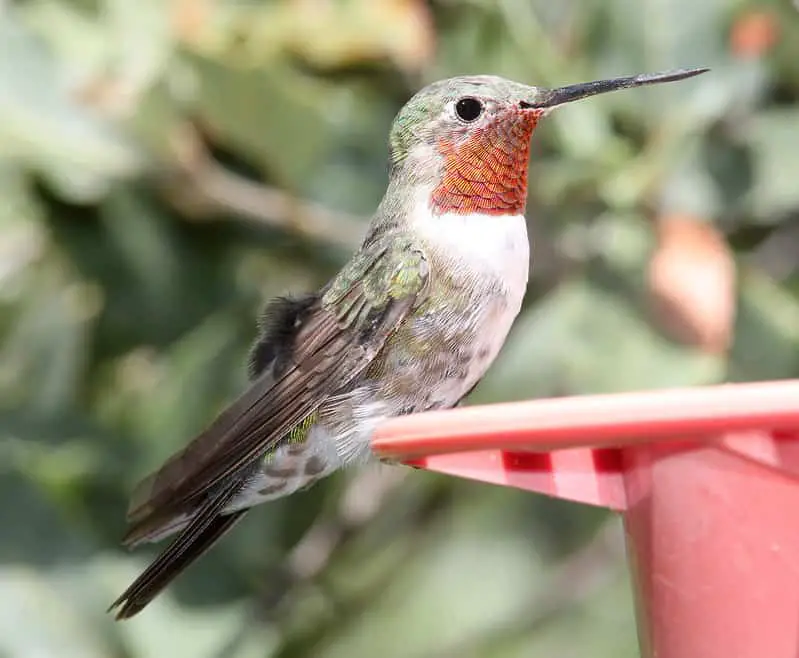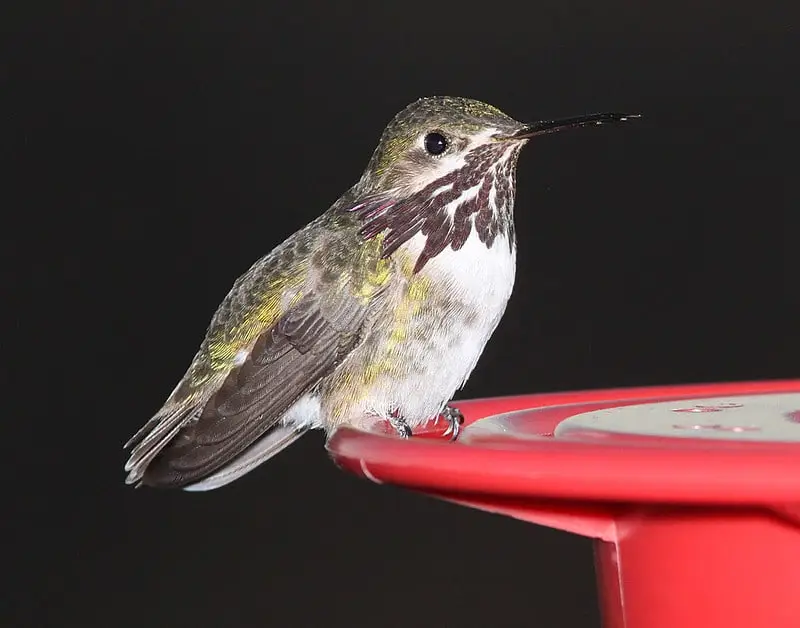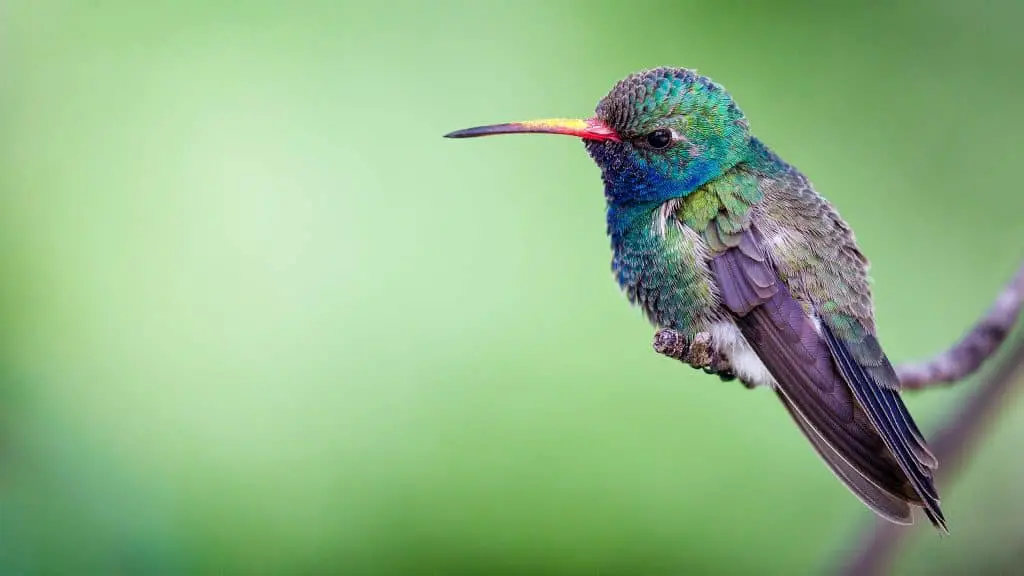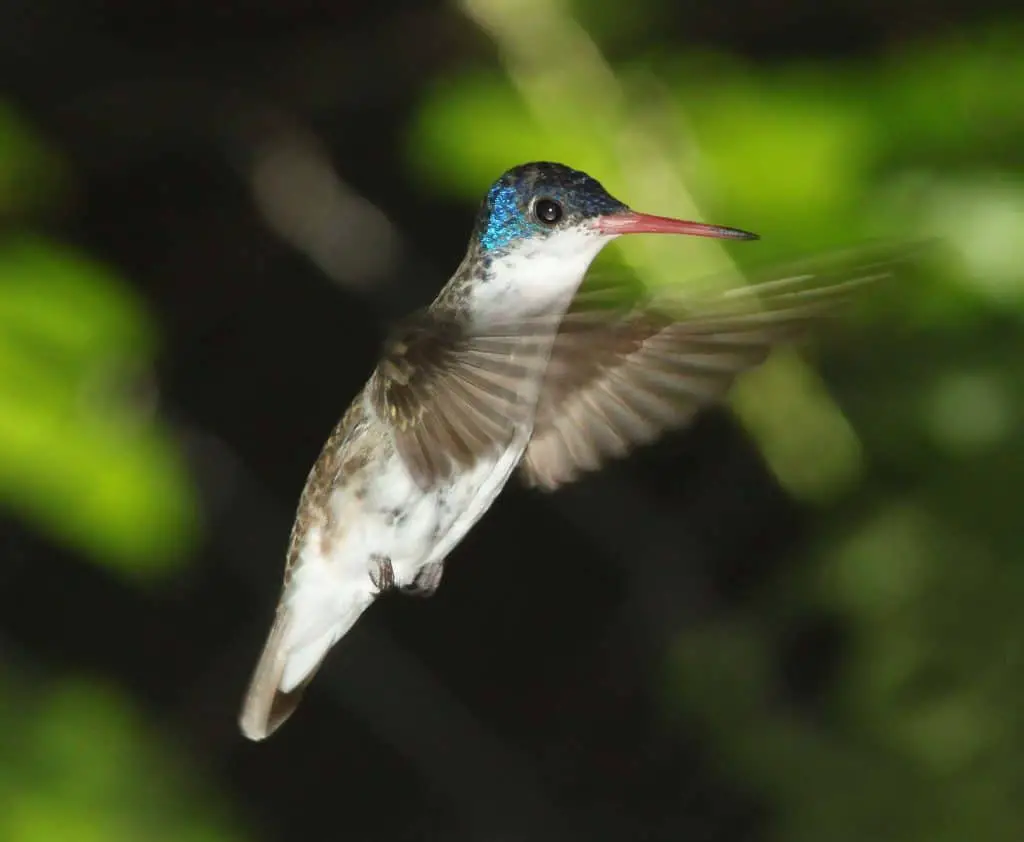
In California, there are 9 different species of hummingbirds can be seen and brought to your garden.
These species are:
- Black-chinned Hummingbird
- Anna’s Hummingbird
- Costa’s Hummingbird
- Broad-tailed Hummingbird
- Rufous Hummingbird
- Allen’s Hummingbird
- Calliope Hummingbird
- Broad-billed Hummingbird
- Violet-crowned Hummingbird
Want to learn more? Take a look at the Compete Hummingbird Guide Book – a classic!
California is classified as having a Mediterranean climate, their summers are hot, and their winters are mild. There are a large number of state parks in California, 300 in total.
And there are 9 different national parks. After briefly looking at California and the hummingbirds that reside there, let’s have a look at the individual hummingbird species in more detail.
Take a look at our article on the Best Hummingbird Feeder!
What Hummingbirds can be seen in California?
Table of Contents
1. Black-chinned Hummingbird

Fun Facts:
- They most commonly consume nectar from flowers but will also eat insects when they are more readily available.
- These birds are very small with a weight range of 2.3-4.9g and have an average wingspan of 11cm.
This species has pale white or grey underbellies that are present on both sexes and the males have dark necks with black and iridescent purple feathers.
They are similar in size to the Ruby-throated Hummingbird and like to stay near rivers.
This species of hummingbird has not had its behaviour documented as much as other species of hummingbird.
It is known that the males performing courting displays that involves dives of up to 100ft.
They have also been observed finding a high perch to survey their territory after they have spent time feeding.
These birds are not year-round residents but can be seen throughout all areas of the state during their breeding and migratory seasons.
Appropriate tubular plants will help as well and remember to change your feeder every few days.
2. Anna’s Hummingbird

Fun Facts:
- These birds will eat nectar from many different flower species and they have also been known to steal insects from spider webs.
- These birds are medium sized for a hummingbird, weighing 3.6g.
These hummingbirds have green and grey coloured feathers covering their body and the males of these species have vivid, deep pink feathers on their necks.
The Anna’s Hummingbird can usually be seen in urban habitats and they are not shy around visiting gardens and feeders.
Males have a courting display involving a variety of swooping dives and dances.
They will also sometimes perform a song whilst doing these displays if a female seems interested. These birds are not monogamous and do not stay in breeding pairs.
These birds can be seen in California throughout the whole year and are permanent residents.
The most common area for recorded sightings is along the west coast. These birds can easily be brought to your garden with simple hummingbird feeders.
3. Costa’s Hummingbird

Fun Facts:
- These birds will feed on nectar and will also quite often feed on flying insects.
- Weighing only 2-3g they are slightly smaller on the hummingbird weight scale.
Both sexes of these species are covered in duller and paler feathers but the males have bright purple feathers on their head and face.
In the wild these birds like to make their nests and territories around desert habitats. Males are very defensive of their territory, especially during the breeding season.
They will call out to defend their territory from a few select high perches. Males have a strict courtship display that they stick to which involves a series of aerial dives.
These displays have been observed performing for as long as 4 minutes but commonly only last around 30 seconds.
Breeding pairs do not stay together, they will usually mate with multiple individuals and the females will be the one to take care of the young.
Whilst their range does not encompass the whole of California they are year round residents where they reside.
They are to the south of the state and can be attracted to your garden by a simple sugar water feeder.
4. Broad-tailed Hummingbird

Fun Facts:
- These birds will feed on an even distribution of nectar and insects, mothers will feed insects to their newly hatched young.
- These birds are medium sized for hummingbirds and weigh 2.8-4.5g.
These birds get their names from their broad feathered tails. Males have iridescent pink throats and both sexes have dark feathers covering their backs and wings.
These birds will mate with several of the species and will not stay together, males will not help with raising the eggs and the young.
They will perform dramatic courtship displays for any females that enter their territory.
Broad-tailed hummingbirds have the ability to go into torpor when it is cold and they cannot find enough food, it is a miniature hibernation where they slow their heart rate to conserve energy.
These birds are not permanent residents of California and can only be seen to the east of the state.
They are only present during their breeding seasons and can be attracted to your garden by using tubular plants.
5. Rufous Hummingbirds

Fun Facts:
- Nectar from tubular plants is the main source of food for this bird.
- These birds are average sized for a hummingbird and weigh 2-5g.
The females of this species have mostly dull and green feathers whilst the males on the other hand have feathers of iridescent orange shades. These birds are usually seen in open areas of land and have migratory patterns.
Rufous Hummingbirds are very aggressive to both their own species and other hummingbird species, they are aggressive over both mates and food.
Food appears to be more important than breeding as males have been seen chasing females away from manmade bird feeders, even in the middle of the breeding season.
These birds are only seen in their migratory season in California and can be seen across the state.
These birds are actually very fond of gardens and may sometimes stay there without any special flowers or feeders. But they may also deter any other hummingbird species from visiting your garden.
6. Allen’s Hummingbird

Fun Facts:
- A lot of this bird’s diet comes from nectar, but they will also eat small amounts of insects.
- They are similar in size to a lot of other hummingbirds, weighing 2-4g.
Allen’s Hummingbirds have feathers that turn coppery in colour when they reach adulthood.
These colours are paler shades on the females and brighter on the males. The males tend to be in more open spaces but they are common near coastal areas.
During the breeding season, males will perform their courtship displays for the females from a permanent perch.
As with most other hummingbirds, males will mate with multiple females and the pairs do not stay together, females will take care of the young on their own.
These birds are only in California during their migratory season and are present on the western coast. To get this bird to visit your garden you will need a sugar water feeder.
7. Calliope Hummingbird

Fun Facts:
- These birds will consume nectar as their main food, usually from cupped flowers.
- Calliope Hummingbirds are on the smaller side only weighing 2.4-3.3g.
Males of the species have scattered purple feathers on their plumage and they have bright white feathers on their body.
They will breed at higher elevations where possible and are commonly found in open areas like meadows.
Males will spend a large amount of their time on high perches observing their territory and they are very defensive.
To court a female, males will put on a shuttle display which involves hovering by the females and making their flapping wings sound like bees buzzing.
These hummingbirds can be seen in California in both their breeding and migratory seasons. Colourful and tubular flowers will help you attract this bird to your garden.
8. Broad-billed Hummingbird

Fun Facts:
- Nectar is the primary food source for these birds but they will also eat insects that they find on plants.
- These birds are average for a hummingbird and have a weight range of 3-4g.
These birds have a bright red bill and are covered in blue and green feathers. They usually spend their time foraging in canyons and meadows.
Males will perform a courtship display for females only when they enter their territory and will call to attract them there. Males will sometimes perform the same display to other males of the species as a warning display.
Breeding pairs do not stay together, and females raise their young by themselves.
These birds can be seen in California during their breeding seasons and they are seen to the south of the state.
You can attract these birds to your garden using brightly coloured flowers and sugar water feeders.
9. Violet-Crowned Hummingbird

Fun Facts:
- The feed on nectar when flowers are abundant and will consume insects as well.
- They are average sized for a hummingbird, weighing an average of 5g.
These individuals have a bright white belly and a blue and purple feathered head. They have a pinkish red bill.
Not a lot is known about this hummingbird, but it is known that they stay mainly along riverbanks and in wooded areas.
Their range in the U.S has not been largely studied but they are known to be common in Mexico.
Their breeding acts have not been well studied but it is known that they emit a squeaky call during their breeding season.
You can see these birds during their breeding season throughout all of California. They are not common garden visitors but they have been seen using sugar water feeders.

More Articles.

How to safely remove a birds nests?
First ensure that it is legal to remove the birds nests. An empty and abandoned

What does it mean when you see a Cardinal?
There are some truly amazing things that the cardinal can represent in your life, whether

What does it mean to see a White Hen in your dream? (Symbolism & Meaning)
Seeing a Phenoix in your dream can symbolize a fresh start, a new beginning, or

About Us
We are avid bird-watchers who recently retired, allowing us more time to travel the world. Fortunately, we have managed to visit numerous countries around Europe, Asia, and America. Watching and photographing birds has been a passion for many years and we are making the most of the extra time on our hands!
